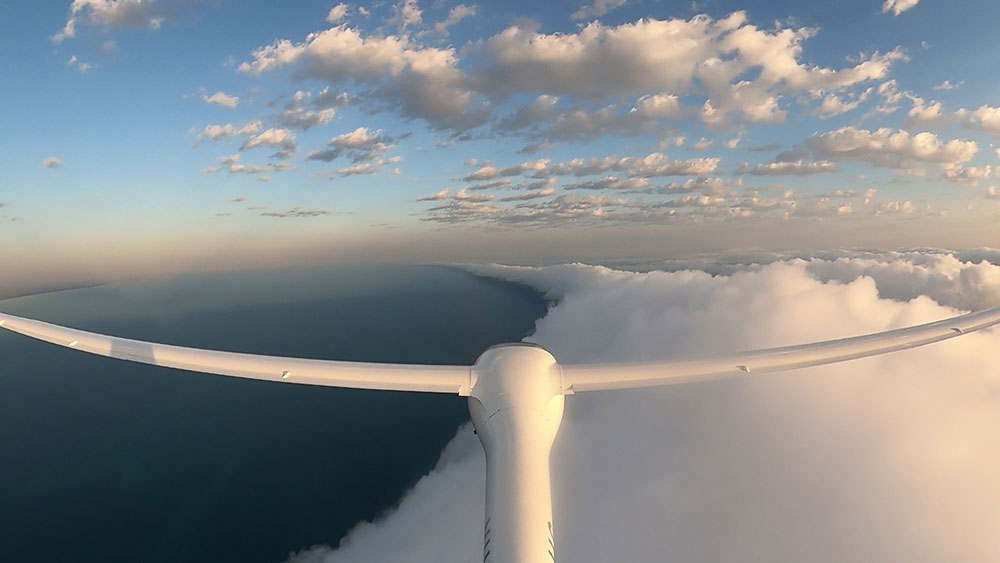
Photo above by Grant Rookes of his Stemme acompanying John Riedl.
Words and photographs By John Riedl
For me, flying the Morning Glory was an unforgettable life experience, one of those rare events that etches itself into your consciousness as something wonderful, different and forever memorable. It’s something that few people have ever experienced, maybe just 200-250 on the whole planet, far fewer than those who have climbed Everest.
The whole experience isn’t just ‘the Glory’ per se, but the entire trip through some of Australia’s most desolate and fascinating country to the continuously unfolding beauty of the Gulf Country on the way up, and the spectacular Queensland Coast on the way back.
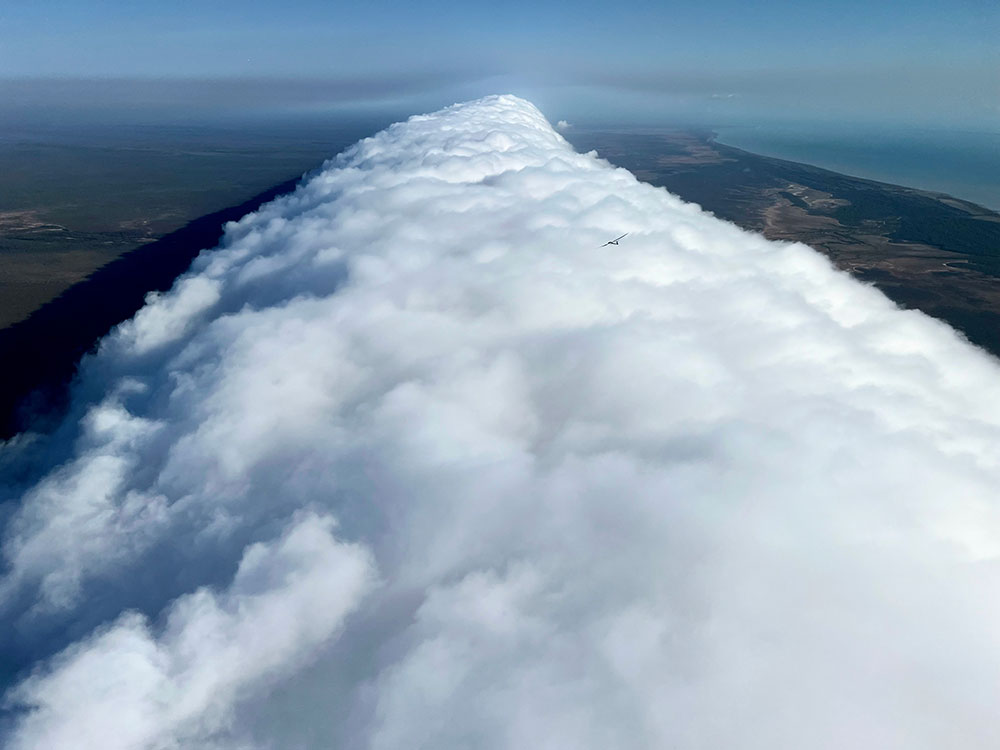
John Riedl and Rob Hanbury ride the Morning Glory wave to cloud to 6,500ft, as another Stemme passes below.
The journey revealed an Australia that I never knew existed and doubt that few Australians have ever seen or appreciate. It’s just so much a sensory overload of endlessly changing terrain, seen in detail at low altitude. If you ever have the chance, go!
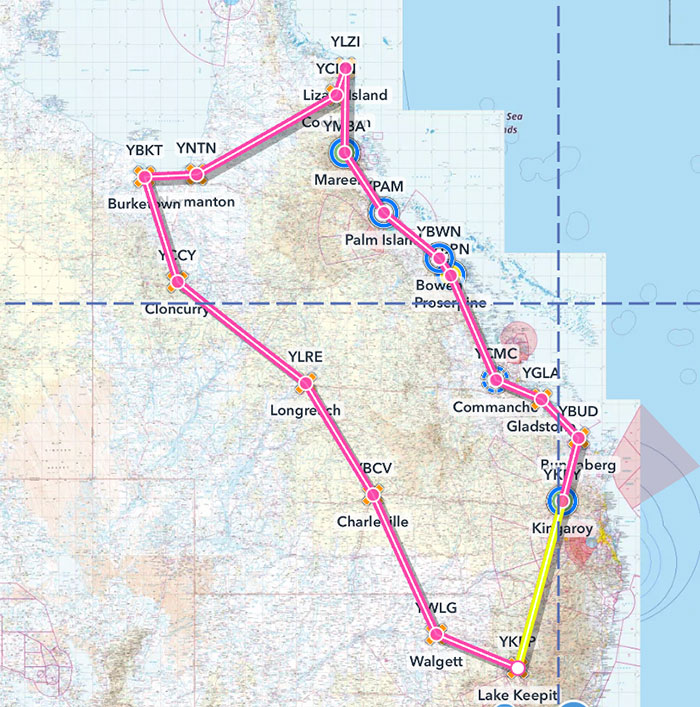
The route took them up the interior of NSW and QLD and back to Lake Keepit via the QLD coast.
Flying the Glory is a great thrill for a glider pilot, but also an achievement that requires significant preparation of plane and, in my case, pilot. I had only logged a lifetime total of 120 hours and was not yet solo in the Stemme, when I flew out. I came back fully certified.
My journey began when I took a week’s ab-initio flying course at Camden in 1986. My instructor was Ray (Rope-Break) Morton, an ex-RAF pilot who famously chose his life’s partner after an unscheduled, overnight stop with her on the shores of Burrinjuck Dam – after the tow mysteriously parted.
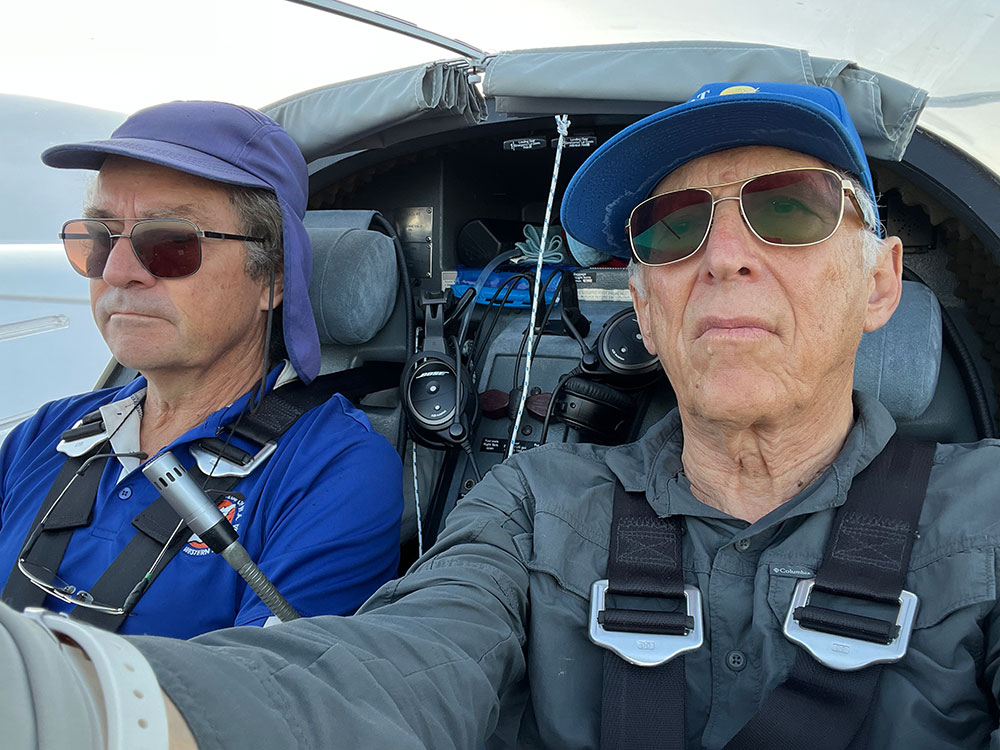
Rob Hanbury (left) and John Riedl flying the Stemme.
Ray supervised my 19 flights (7hrs 21min), including two solos, all in the ASK13. Busy at work, I then stopped flying for 35 years, returning in November 2021 to learn to fly again over a much-changed Camden landscape. After a few flights, and re-visiting a favourite 1970s photobook, ‘Australia – The Greatest Island’, about an aerial circumnavigation of Australia, I decided that I wanted to make the same trip. I purchased a Stemme touring motor glider the following month, December 2021.
Controversial Stemme
My Stemme S10V was manufactured in Germany in 1995. It has 23m folding wings, 50:1 glide ratio and a folding variable-pitch propellor driven by a Limbach 2.4 litre engine situated at the C of G. The engine is behind the pilots, who sit side-by side under a large canopy with excellent visibility. The propellor is driven via a gearbox, clutch and a 2m carbon-fibre shaft between the pilots. There is an electric undercarriage, and the aircraft must self-launch. Fuel consumption is about 14 litres an hour from wing tanks totalling 90 litres, and it maintains a cruising speed of 85-90 kts. Flaps range from +16 for landing, +10, +5, 0, -5 and -10 (for 80 kts plus cruising). Vne is 146 kts.
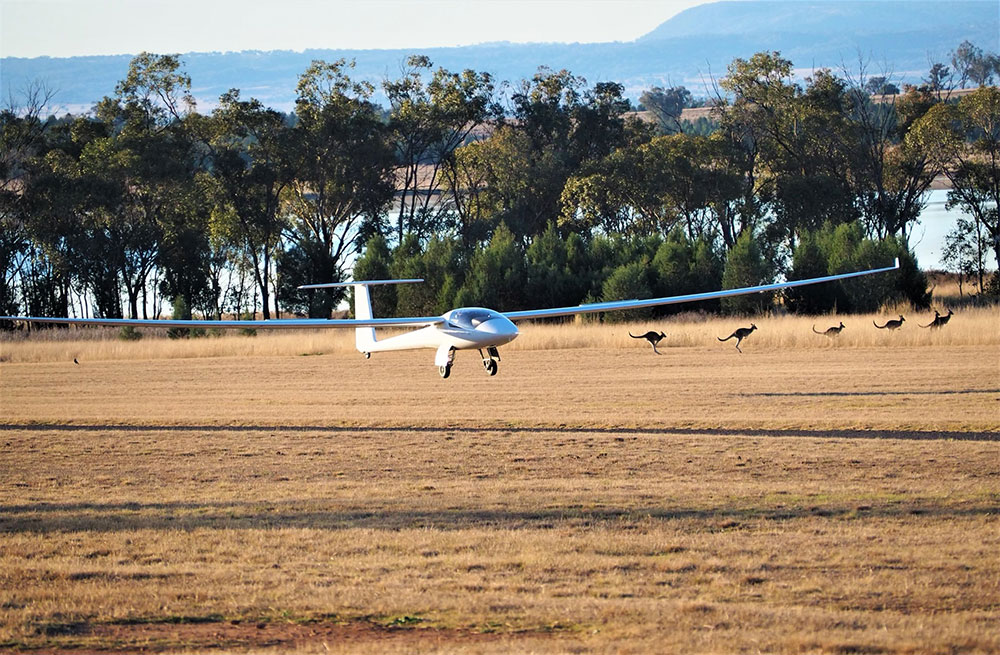
BELOW: Taking off at Lake Keepit.
Buying the Stemme was somewhat controversial, and not just with my family. I was effectively an ab-initio trainee at age 77, with no qualifications. I rapidly attracted a large number of people telling me that I was crazy to attempt to fly again at my age, that a Stemme was far too complex and difficult for a first aircraft, that 23m wings and a narrow undercarriage would not allow take-offs and landings in anything more than 3kts of crosswind and so on. I tell the story to encourage others to persist.
I first had to re-qualify in conventional gliders. This was logistically, rather than technically, difficult. Every time I got close to going solo, after about 20 flights each time, we were shut down for months by Covid, endless rain or major flooding, or simply by continuing bad weather. After each enforced stoppage, I had a new instructor, who wanted to start at or near the beginning, every time.
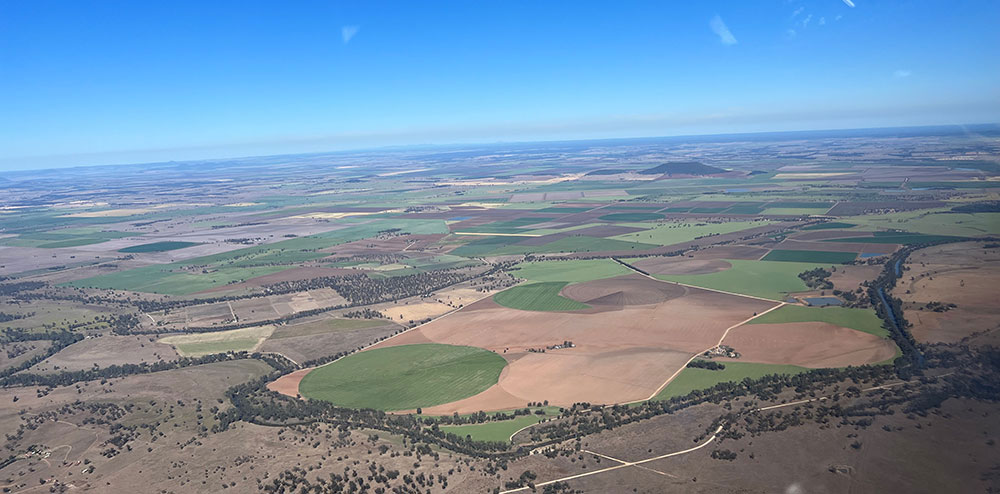
Re-qualified and Fully Loaded
I attained my A, B, C Certificates, GPC, DI, passenger and cross-country ratings and my independent operator certification by 2023 and started flying a PW5, an ASK21, a Duo Discus, a Ximango and a Dimona, with only a small number of flights in the Stemme, which I could not fly without an instructor. The problem was that only three or four instructors in Australia were qualified for it, and weren’t necessarily located anywhere near where it was hangared in Lake Keepit. It wound up there as the cost of a new T-hanger for 23m wings proved prohibitive in Camden.
Many people helped and, by mid-2023, I could gratefully fly the Stemme quite well, but not yet solo. Then, Rob Hanbury, an experienced Stemme pilot and instructor, and I took off fully loaded from Lake Keepit on 24 September 2023 on the way to the Morning Glory. This first flight was to be 8,000km with 60 hours in the cockpit.
The first segment was over beautiful, well-irrigated farmland and blue skies, 246km from Keepit to Walgett, a rough town with a crime problem and everything locked up. Its airport and surrounds were ominously empty. Then, after two and a half hours and 453km, we arrived at Charleville, flying into slightly increasing haze at 6,500ft. We encountered more farms, but the land had become drier with different farming patterns, with clay roads in strange patterns cutting up vast areas. We refuelled and headed off for Longreach, the home of Qantas.
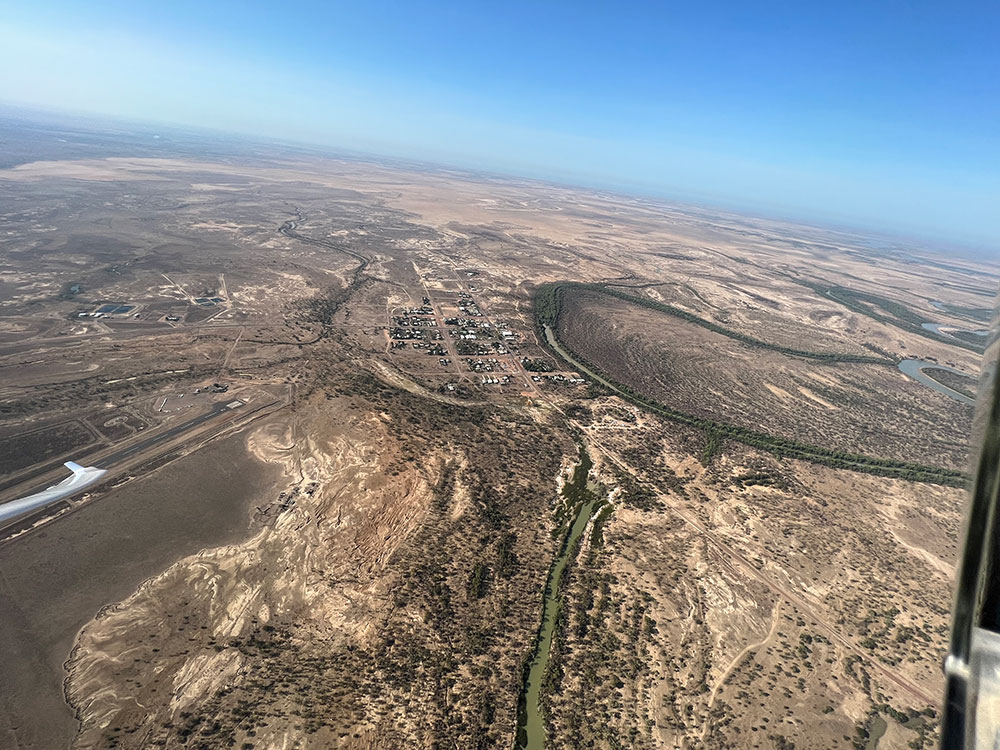
Desolate
On this leg, we flew over really desolate country – low, scattered scrub, very dry and hazy, unfriendly, unlandable and vast, just vast. Thermal activity increased, the bumps forcing us up to where it was cooler and more comfortable at 6,500ft. We dolphined, pulling up and slowing to 55 kts in rising air, speeding up to 110 kts in sink, to average about 170 kph. As I looked at the hostile land, I felt glad to have a lot of water aboard and two satellite phones. There is often a cellular connection, but no habitation for 80 to 100km at a time. After 2 hours 45 minutes, we final glided 50km into Longreach.
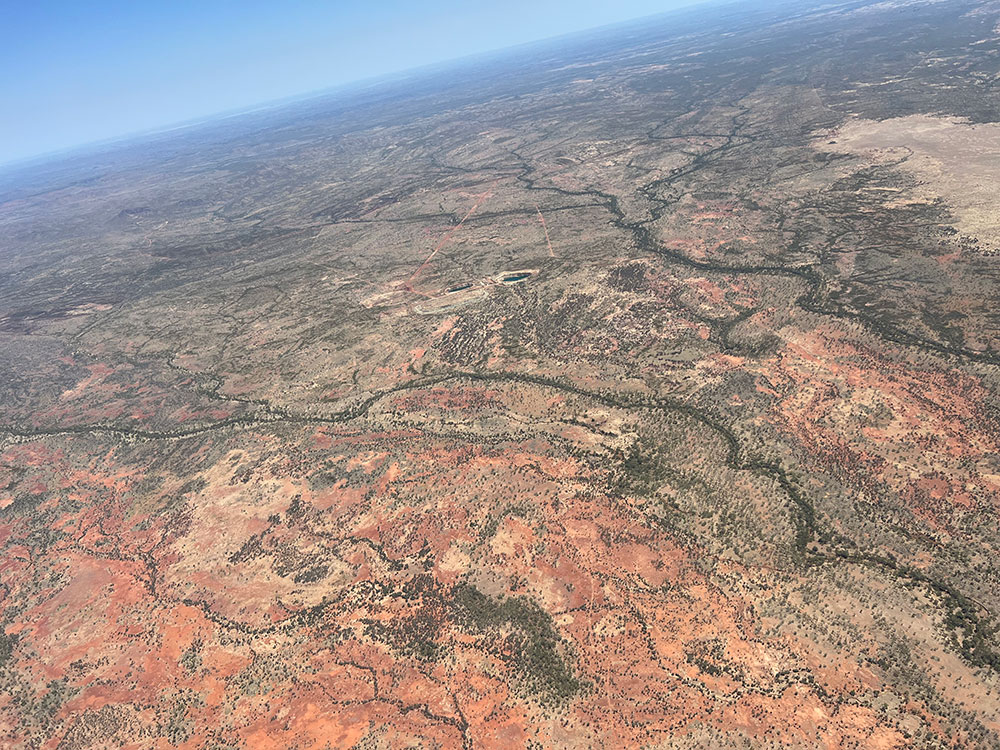
Longreach has the Qantas Museum, with aircraft from a DC3 to a Lockheed Constellation and a 747. It also features the largest caravan park and motel complex I have ever seen, with swarms of little songbirds breakfasting on insects as we took off in a 20 kt, gusty wind. We were now over the Channel country where cattle stations lay at 80km separation and vast numbers of intertwined dry creek and riverbeds were left from the wet season. A few mines appeared, but were desolate and abandoned. Tough people somehow traversed this sun-blasted land over past ages. 500km took us to Cloncurry, gliding the last 50km as we did on all our legs.
More wind and heat now prevailed – 40 degrees on the ground. We took off to cruise-climb, very slowly, in low density air with a lot of thermal activity. The Stemme’s 23m wings mean that it has a slow roll-rate and, compared with a PW5, it is a bit like waltzing with an elephant. But on that day, a single turn centred a thermal at 500ft, which took us to 9,000ft and blessed, cool, calm air with the vario yodelling, and the needle jammed off-scale over 12 kts. The desolation was different now. The land was still almost completely unlandable and questionably survivable, with the odd remote cattle station and waterhole for the tough Brahmin cattle that can resist the voracious northern ticks.
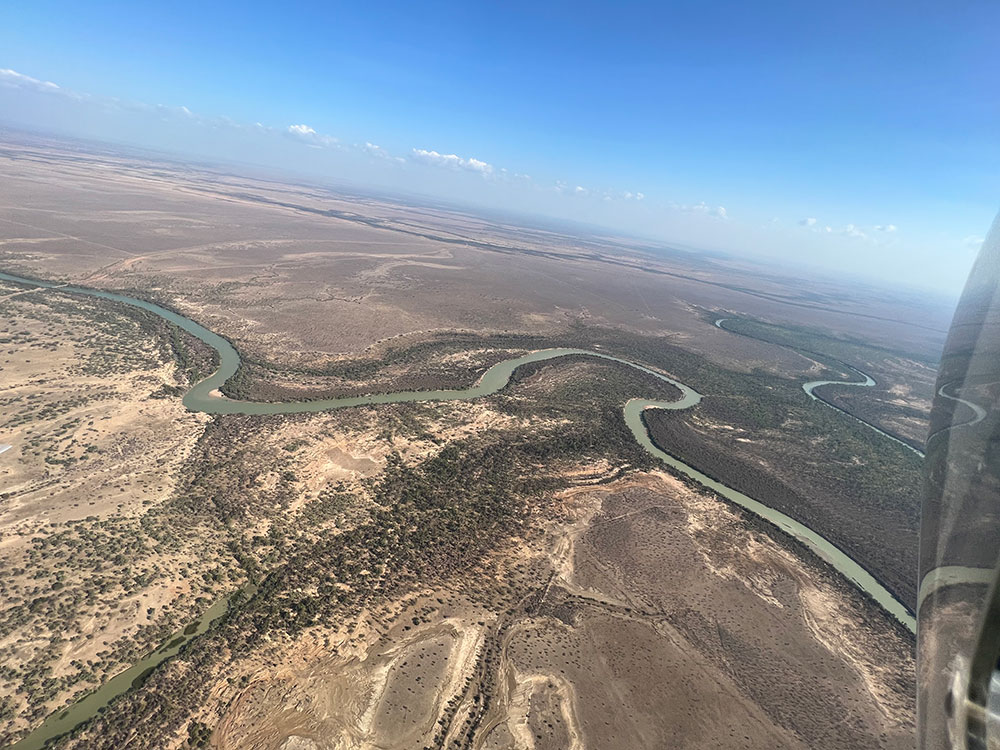
Serpentine Rivers
Then we entered the riverine Gulf Country, much greener and more photogenic, gliding without motor at 200 kph to land at Burketown and start the Morning Glory part of the trip.
Here we had three serpentine rivers, snaking with endless turns through tidal flats and mangroves, and no shortage of water. Dendritic shapes were revealed in all the innumerable creeks, fires in the scrub on the horizon and Burketown ahead. Burketown, as in Burke and Wills, marks the northernmost point of their expedition, where the mangroves finally stopped them.
We found the Barramundi capital of the world sitting on a billabong, cut off from the river by an inconvenient new bend but otherwise navigable to the sea. There was one good lodge, one caravan park, one pie shop and one pub – and not a lot else. Large frogs were living under the loo seat, cane-toads inhabited the garden and wallabies skittered past so quickly that it made me weep for the footballer version.
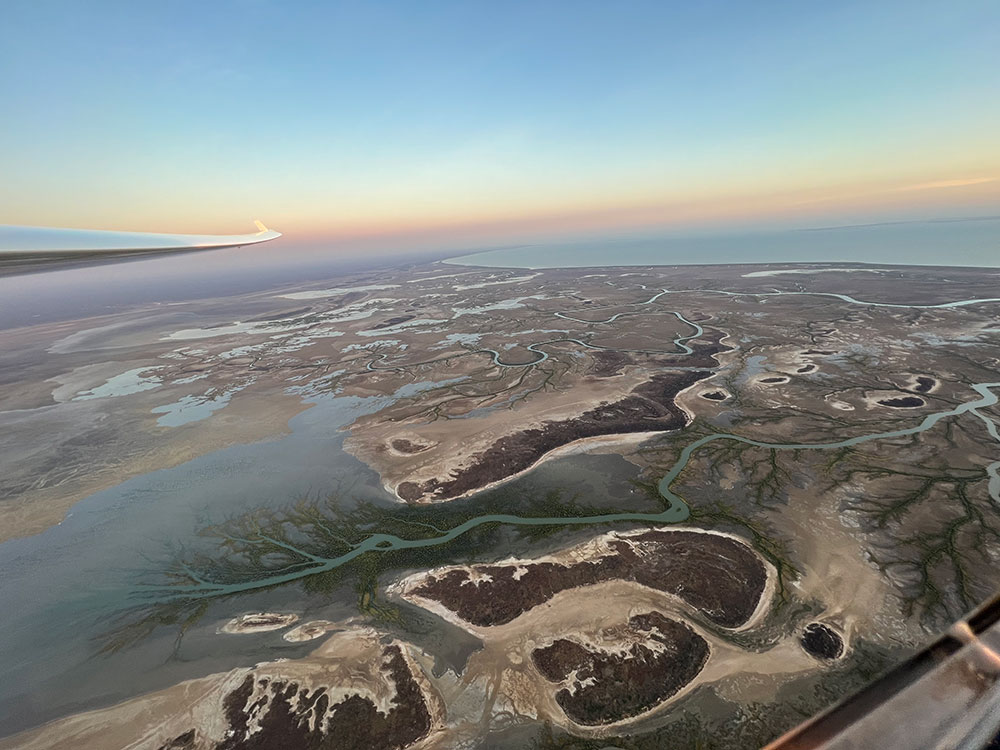
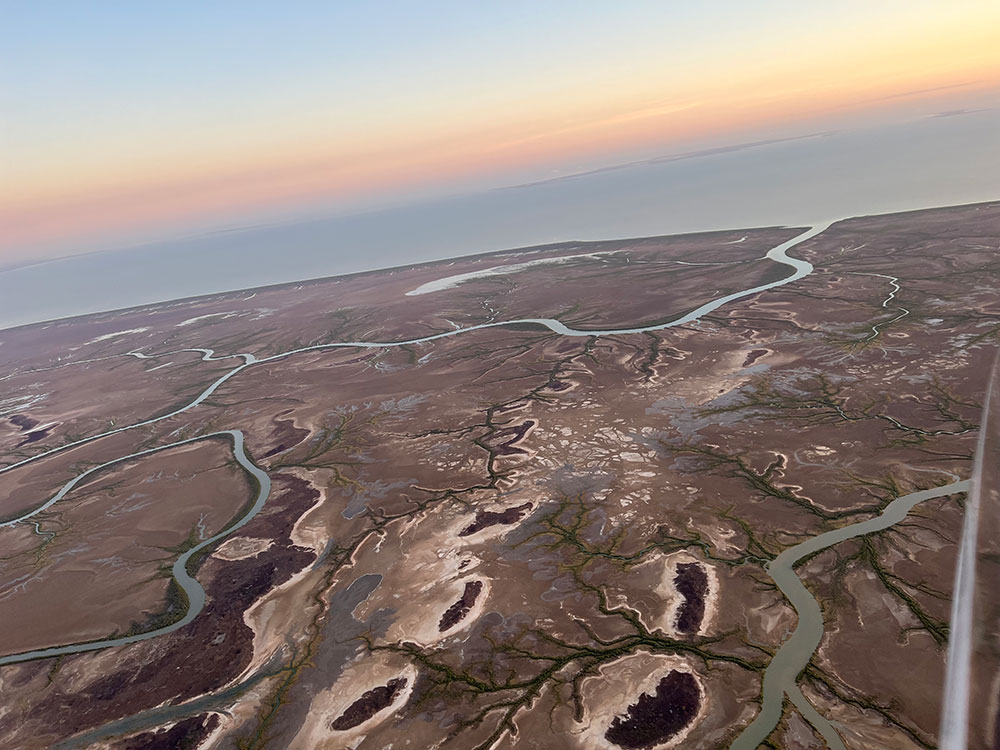
Tidal Flats on Day 3 as we head out from Burketown to the Gulf of Carpentaria, searching for Morning Glory.

Dendritic drainage pattern on tidal plates on one of the rivers near Burketown
A Few Hail Marys
On our third day at 4.15am, we went cross-country to the airport, trying to avoid wombat holes and steep, flood-eroded channels. The Milky Way, an incandescent ribbon, illuminated the moonless sky. We keyed the CTAF frequency and the aerodrome lights came on, allowing us to DI and prep the aircraft.
At first light of 6.06am, eight gliders climbed towards the glow on the horizon, searching for Glory. Some pilots wore life jackets, while others considered that, with 20ft Salties on what passes for beaches and 12ft sharks in the shallows chasing Barramundi with a side of aviator, the best thing would be to ditch in the deep and try a few Hail Marys. We were heading 50km off-shore before sunrise, with zero thermal lift, and were happy to have spot trackers and beacons. We climbed to 8,000ft to preserve glide to Sweers Island, or the mainland – our 50:1 wings felt good at that time.
The engine purred. No drama, no luck, no Glory, but a long final glide and a nice Barra Burger at the pie shop. Rehydration then involved beer as the day progressed. At night, one unfortunate pilot asked a rather butch waitress, who is new to Burketown, if they had had a Morning Glory that week. The resulting indignant fracas took some sorting out.
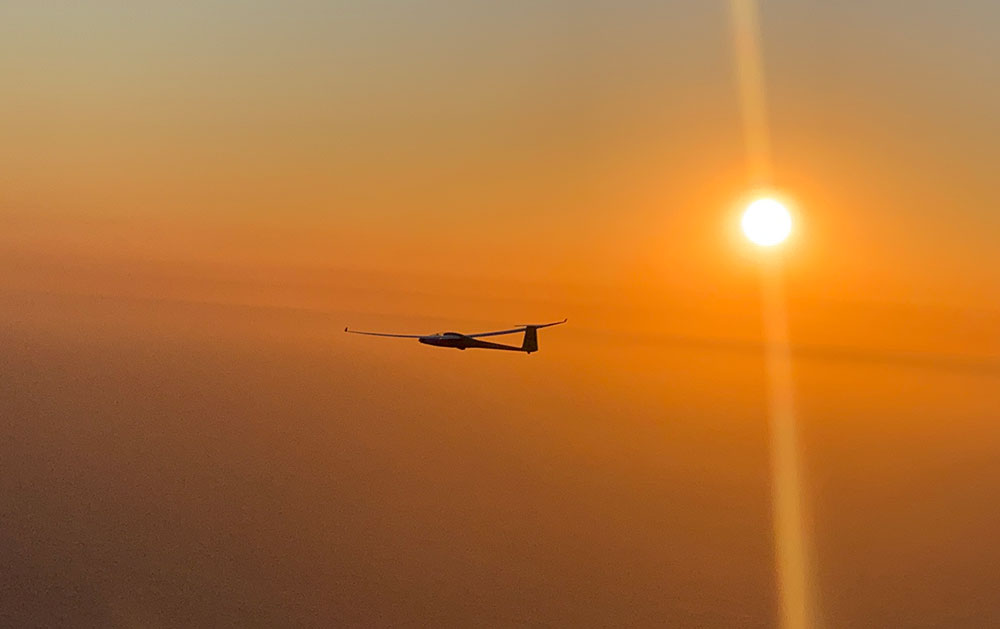
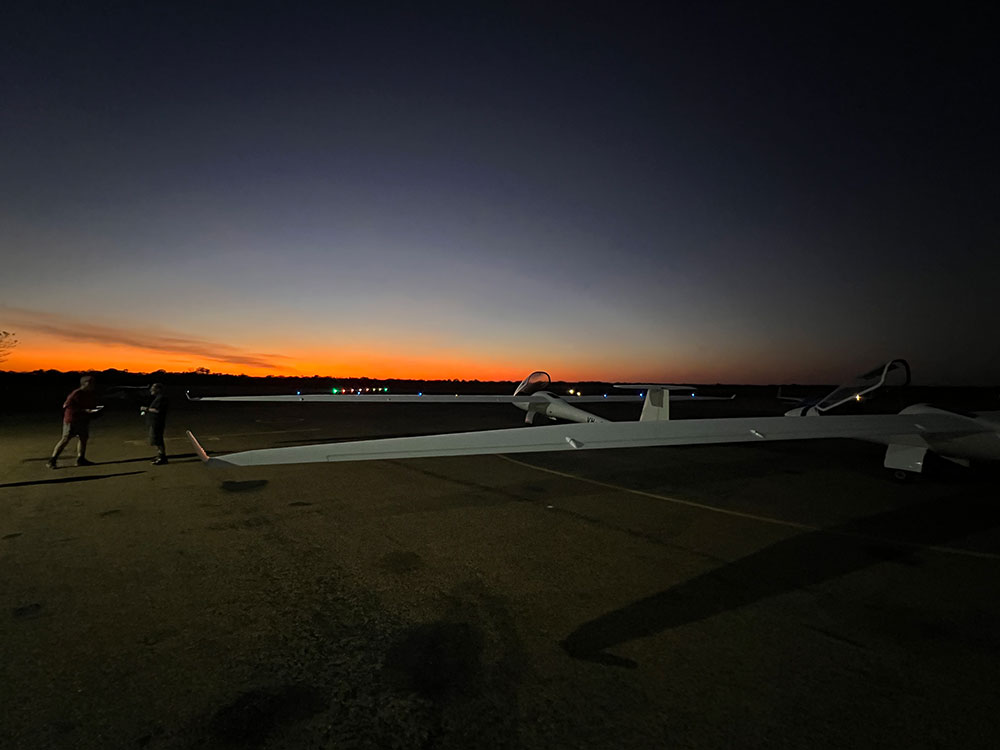
Wall of Cloud
The next day, we had luck. We came down to the airfield to find the gliders dripping wet – the next best sign after condensation on a beer glass the previous night at the pub. We cleared the ground at 6.16 am and headed for a faint line on the horizon 50km away.
Passing Bentnick and Sweers Islands, where there is a strip, the Glory stretched from horizon to horizon, its base at 500ft and top at 2,500ft. It was clumpy, cumulus-like, with a leading edge rising at about 75 degrees to to the horizontal. It was also bigger and further out than we had thought, taking 15 minutes longer to reach than expected. With a wall of cloud to the right, we gingerly felt for the lift, shut down the engine, housed the propeller, retracted the nose cone and entered the rising air at the leading edge, as a glider.
The vario, mournful at first, yammered away as we moved down the front face of the cloud to the stronger lift. Flaps at -10, we increased speed to 140kts in beautifully calm air and after 25 minutes, came to the end of the cloud. The wave probably went further on – it certainly went well in front of the cloud at times – but we wanted to stay with what we could see.
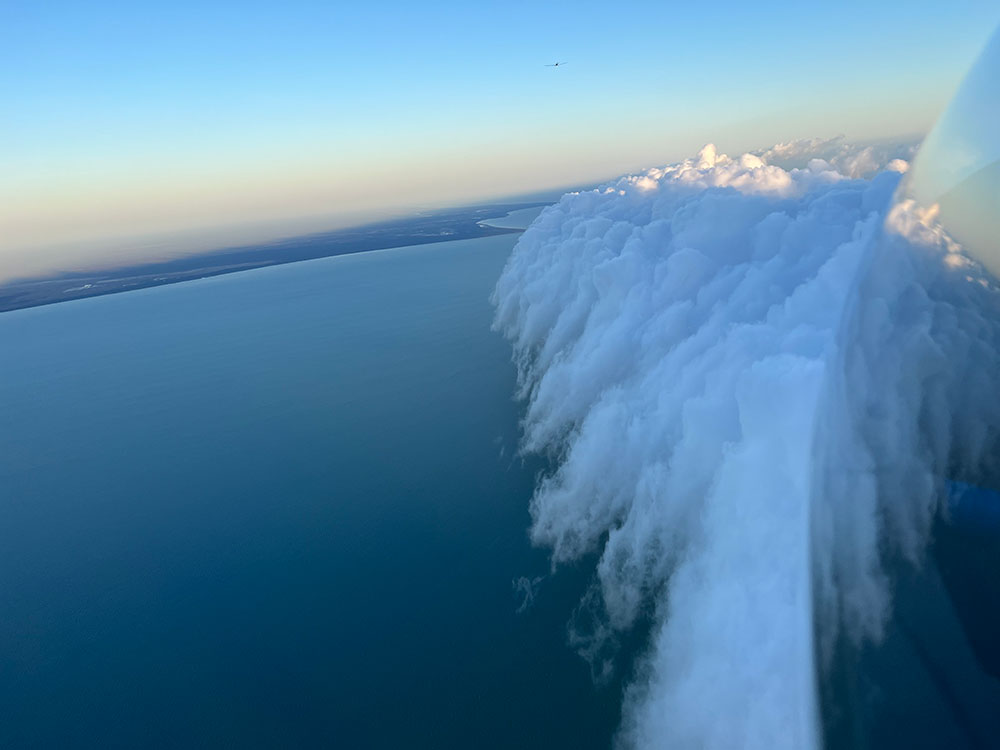
Entering the lift in front of the first Morning Glory on Day 4.
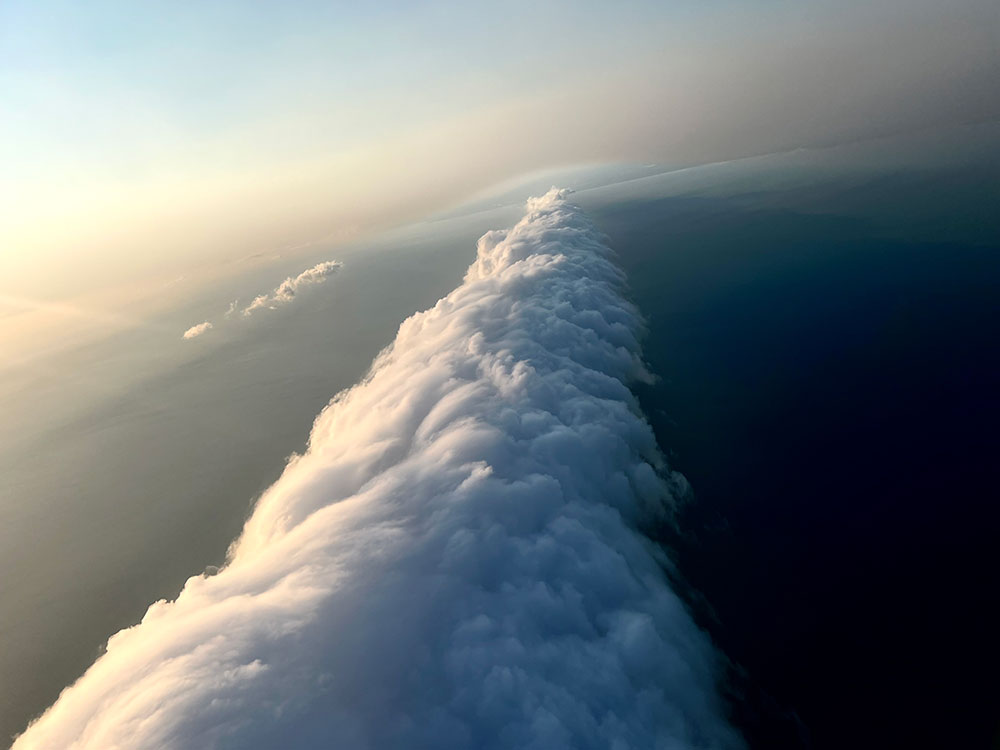
You can’t see the scale from the photo, but it is immense, like the breath of God!
Ski Slope
Reversing direction over a leading edge that flattened into a glorious ski slope, we skimmed the surface – it really was ridge soaring – changing from near Vne at 1,000ft, to 60kts at 2,500ft, as the whole, fantastic assembly swept towards the land at 40kts. We were very close to the cloud, a skier following the slope contours, one hand wing-tip occasionally touching the cloud, even disappearing momentarily into it.
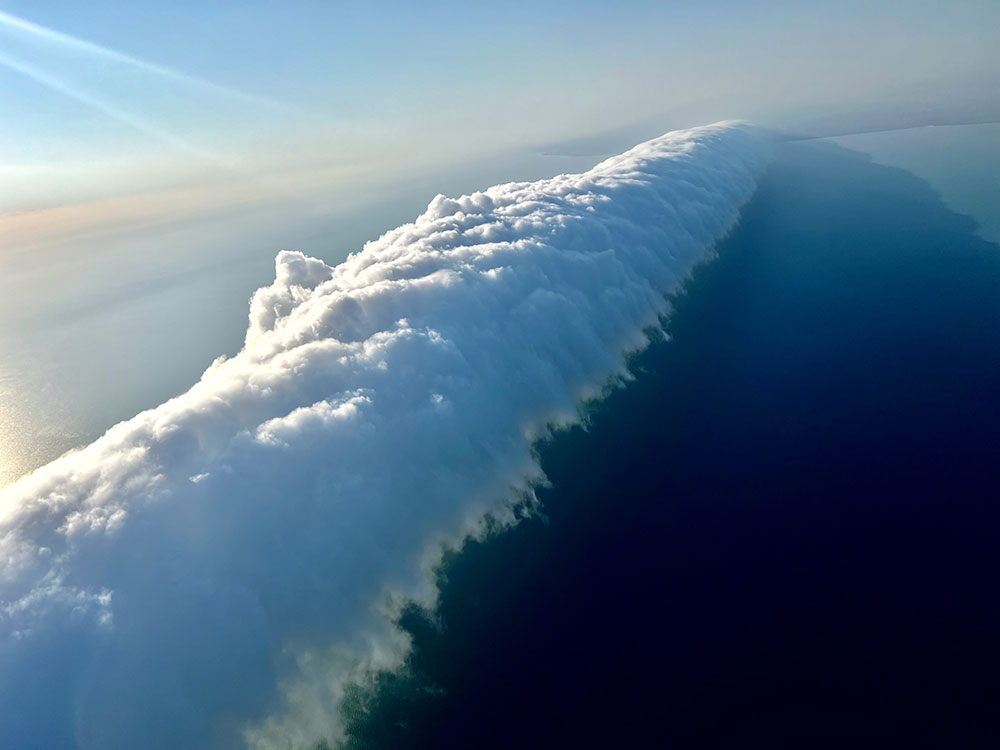
Tendrils of cloud reached up, the inverse of the dags under cumulus, and the glider shuddered as they whipped past the canopy. Near Vne, the vario yammered joyfully and the whole glider thrummed and sang with a resonant note as it reached the limit of its capability.
We made six runs and found ourselves far inland and 150km from Burketown, with the sun now up and our crew hungry for breakfast. The Glory was breaking up now, its energy largely spent, and so we glided to a second Glory further out towards the sea, and stole a ride, prior to starting our engine and heading home over more unlandable terrain, and a final glide of 50km by 9am. We had completed 451km in 2hrs 52mins and done something unique, all before breakfast. What a privilege. It was good to be alive.
Sound of Brolgas
First light on the 10th day saw eight powered gliders, one just leaving the ground as another came to full power behind it. The gliders had been covered in condensation, dripping wet, when we arrived to the sound of Brolgas in the swampy land behind the airport. It was an auspicious sign of a Morning Glory.
Several eagles flew patrol overhead, eyeing the gliders with suspicion. The sun just broke the horizon as we reached the coast, our 3,000ft height bringing the dawn early.
This Morning Glory looked different, much bigger than the last one. Stretching from horizon to horizon, it was just vast and, with the engine off and propeller folded, we initially rode the lift above the cloud at 200 kph, later descending to play near the surface. You can’t see the scale from the photo, but it is immense, like the breath of God!
The pilots radio chattered their positions to each other, as gliders closing at 250+ kts in opposite directions can be hard to see. The cloud passed over a large island, which took a huge bite of the energy of the centre of the cloud, dividing it into two, with a turbulent, clear-air bridge between them. There was still lift, but suddenly no cloud.
Then the cloud swept from the sea to the land, which fed hungrily on its moisture and energy, untill it was a small fraction of its former self. We made 10 runs along it, from end to end, but each one was shorter as it headed inland and shrank in from the ends. Some of these Glories can be 1,000km long.
Then we turned for Burketown and breakfast, gliding down from 5,000ft over brown land after starting on a wine-dark sea.
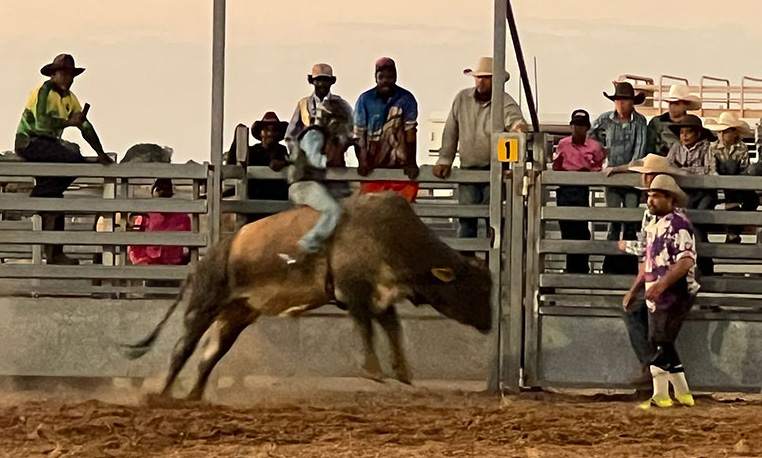
Rodeo at Burketown.
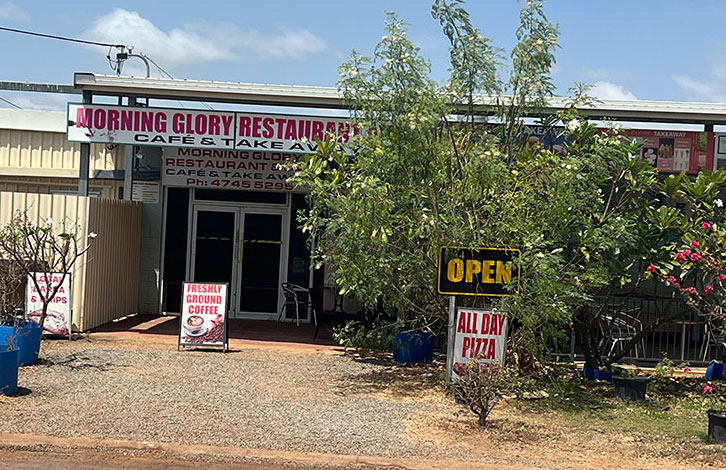
The best restaurant in town - the Pie Shop also known as 'the pilots waiting room'.
Cowboys
Burketown was suddenly full of hundreds of cowboys, bulls and horses for the annual rodeo, where white and aboriginal kids mixed, playing and hugging each other with no affectation. It was great to see. The country music was not quite so welcome.
The bulls came boiling out of their stalls, routinely unseating their riders onto the red dust, and then nonchalantly turned immediately out of the nearby gate and went back to the cattle yards with no urging. They had done this before and knew the drill.
The local population got slowly and convivially plastered in the rodeo heat, with three times as many at the bar as at the bull and horse ring, where indignant horses were now working much harder at pulverising their riders than their heavier bovine cousins had earlier on. There was a super community spirit. The pilots went to the best restaurant in town, the pie shop – also known as the pilots’ waiting room – and swapped notes. Everyone should visit Burketown.
2 Trillion Tons of Air
That night brought a special change in the weather. There are 2 trillion tons of air sitting above the York Peninsula on any one day. That day, a quarter to a third of this was heated by the sun and rose, leaving a low-pressure zone, a partial vacuum. The colder, denser air over the sea and ocean on both sides of the peninsula, rushed in to fill it and collided, head-on, in a line down the middle, sometime after nightfall. The shock wave propagated up and out, billions of tons of it, rolling and roiling and collecting vast amounts of humid air as it raced, in our case, across the Gulf of Carpentaria.
One massive component, a true Monster of a Morning Glory had come to us, just a few kilometres from the airfield as we took off in the pre-dawn light of our 11th day.
This one was the largest by far, and well over land by 6am, very low and quite menacing, but stunningly smooth, with a turbulent second and higher wave behind it, slowly catching it. I don’t know how to convey the scale, power and energy release as it swept over the foggy land, absorbing the fog that sat like spiderwebs on the ground. The moisture and its latent heat, released when it turns into the water drops that are cloud, is what drives the Glory.
I am a skier and I thought, this is the perfect slope. Angels probably ski on stuff like this.
The following angry, secondary wave loomed, just behind. As we skimmed along at speeds up to 270 kph, our redline for structural integrity, the sun rose…
Moving to the front of the wave, we descended from 2,000ft to 800ft, well below where we would normally be thinking of nothing but landing. The lift was strongest here and we could fly at or near the redline in smooth lift, the vario yammering, with no engine.
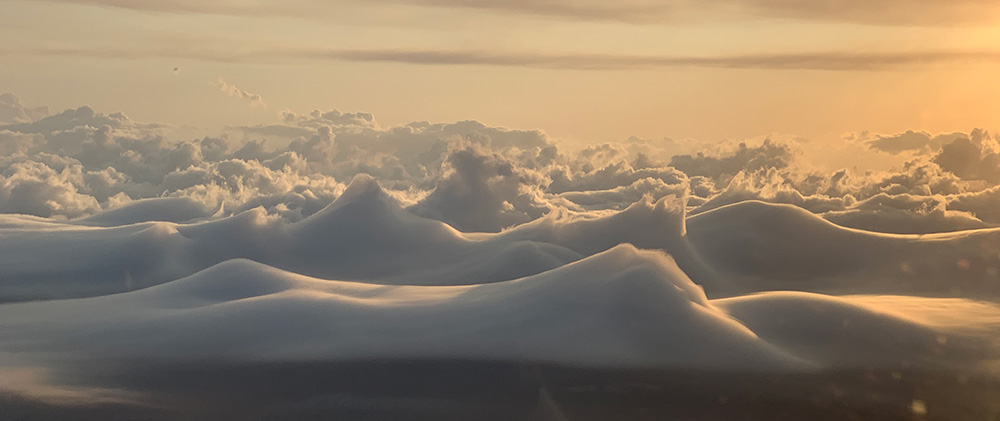
The ‘Meringue Pie’ created when the secondary wave caught up with the primary Morning Glory.
Meringue Pie
The energy release was colossal, enough to lift every glider in Australia, ten times over, all at the same time.
The details of the land were very clear here, cattle too and moving very fast, just below. Zooming back above the cloud to take a video in the streaming sunlight there, briefly distracted, we blundered by going too far to the lee side and found ourselves very close, too close, far too close to a vast, flat surface that was moving as fast towards the leading edge as we were. Now in weak lift at less than 60kts, almost all of our kinetic energy was expended in our rapid climb.
We were making an emergency engine start when we crept over the edge and escaped down to the strong lift at the front of the Glory. The second, turbulent Glory then caught up with the first, turning its perfect smoothness into something that looked like a meringue pie near one newly created end of what had seemed to be an endlessly rolling, tubular mountain range of smooth white, just an hour earlier.
We tried to fly near this, but it was like flying through a tumble dryer. We very quickly quit and went back to the smoother parts that were now breaking up. We had completed 400km and 5 legs in 2 hours.
Under power, we crossed to the secondary wave to test the lift there, but without much luck, and so we returned to the primary, which was very much waning. We then left the cloud, which had travelled 80km downwind since we joined it and flew 110km north to breakfast on Sweers Island, some 40km off the coast. Making a challenging landing on a narrowish, gravel strip in a 15kt crosswind, we stopped for a great breakfast, lunch and exploration of the island.
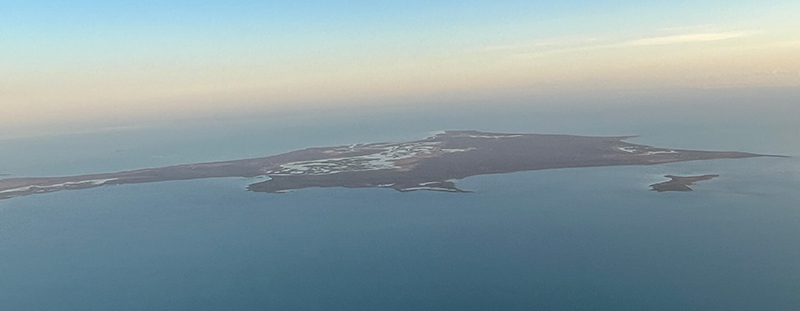
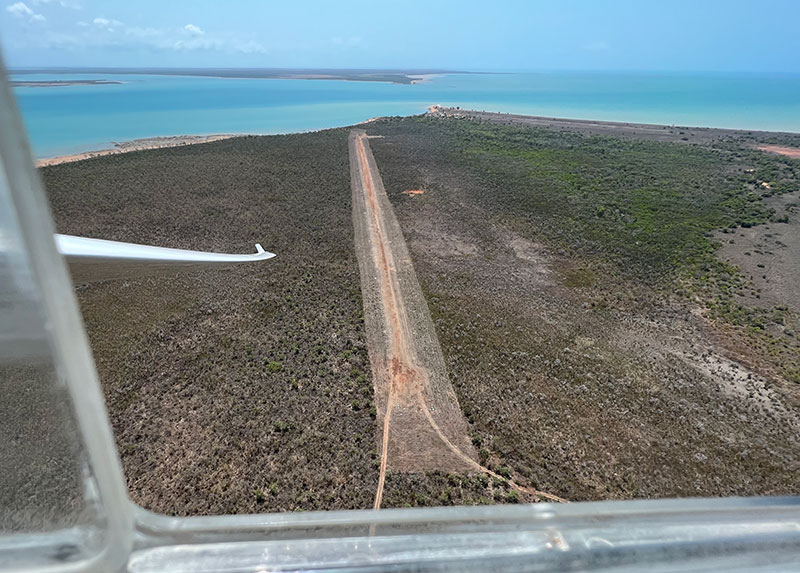
Bentinck and much smaller Sweers Island 40km off the coast from Burketown. John and Rob flew in for breakfast on Sweers Island after flying the Glory.
Seriously Big
Twelve gliders jostled to be first off at 5.59am on our 12th day to meet another ground-stomping Glory, running inland and parallel with the coastline. Everything was dripping wet with humidity, canopies fogging till the ground dropped away. No smooth cloud was to be found here. In the distance, it looked like the Rockies.
Closer and to the south was the typical smooth Glory but, attached to it was the secondary, turbulent wave and a third looming very close behind. It was a wide mountain range moving voraciously over the land. We headed south, leaving the meringue pie of the northern peaks to others more adventurous than us.
But even the ‘smooth‘ part here was not as smooth as the perfection of yesterday, not even close, but showed a complex pattern and internal structure. It was joined to the secondary wave making it very, very wide. I have no unused superlatives left, but this was seriously big.
We turned off the engine, shrouded the propeller and gingerly felt for the lift, which was strongest in the middle of the ‘blue’ ski slope at the leading edge.
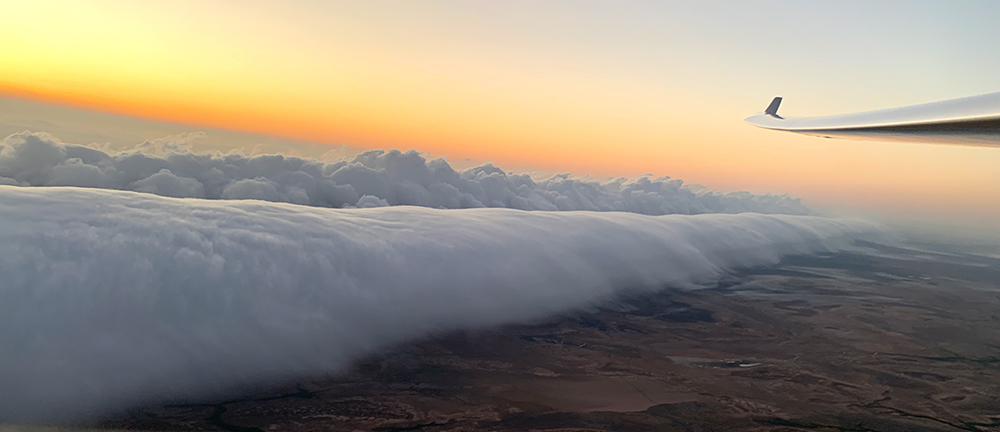
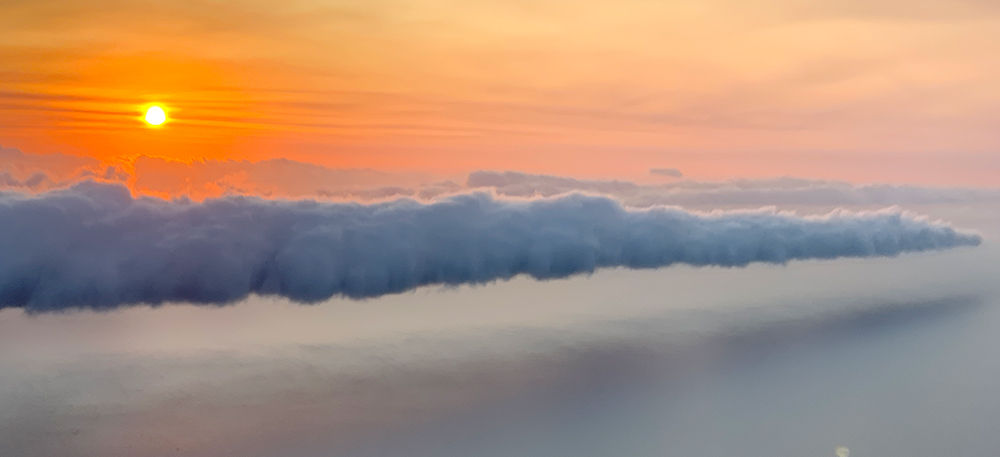
Going Home
The lift today was stable and moderate, probably due to the now linked secondary wave sucking energy from the primary. Flying more conservatively today, with an unknown type of double wave, we skimmed close to the surface, following the hills and hollows, cliffs, bumps and features, with a wingtip almost touching, like a good skier extending a knee to the snow in a sharp turn.
When we zoomed up and further to the front of the cloud, our companion Stemme showed up beneath and slightly in front of our wing tip. The weather started to change and the smoothish cloud got messy further to the south as all three clouds merged into a roiling mess, which we stayed well away from.
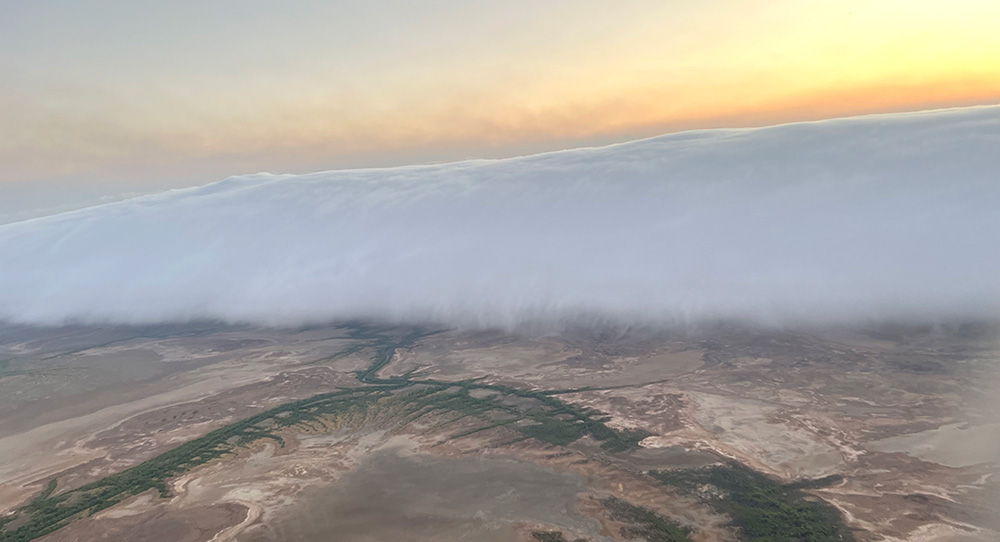
Incoming Morning Glory, Day 11.
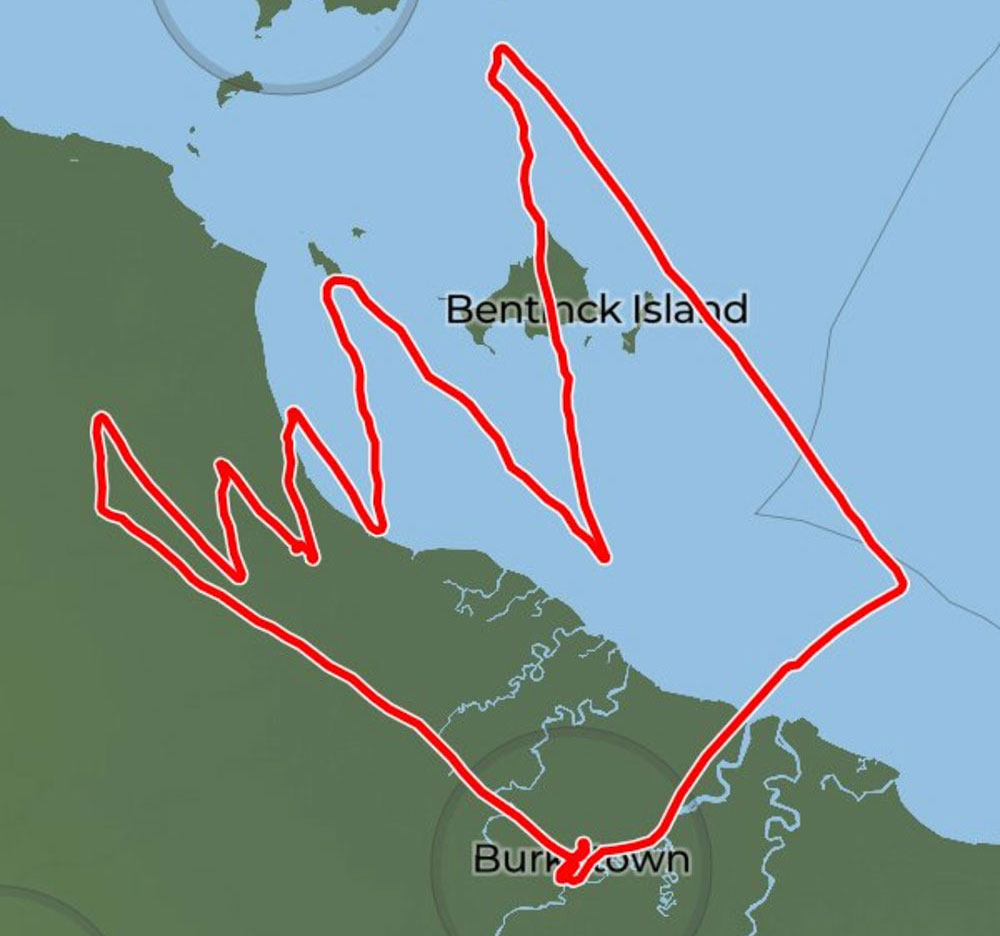
Four runs north/south, and 370km in 2hrs 20mins, took us back near Burketown, with thickening cloud everywhere, forcing us to power up – or rather, down – low under the massive grey ribbon of the now decaying cloud as our only visible way home.
Passing hundreds of cattle at a waterhole towards Burketown, we had completed 25 runs on the Glory over four days.
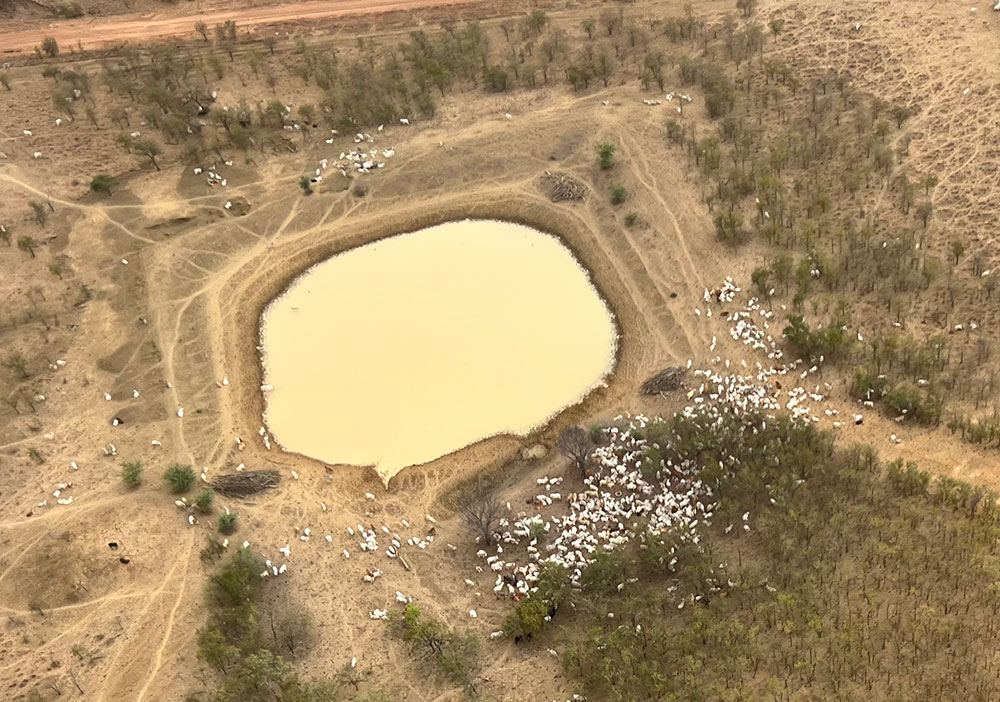
The trip home via Lizard Island and the Queensland Coast, was also just stunning and will be explored in a separate article.
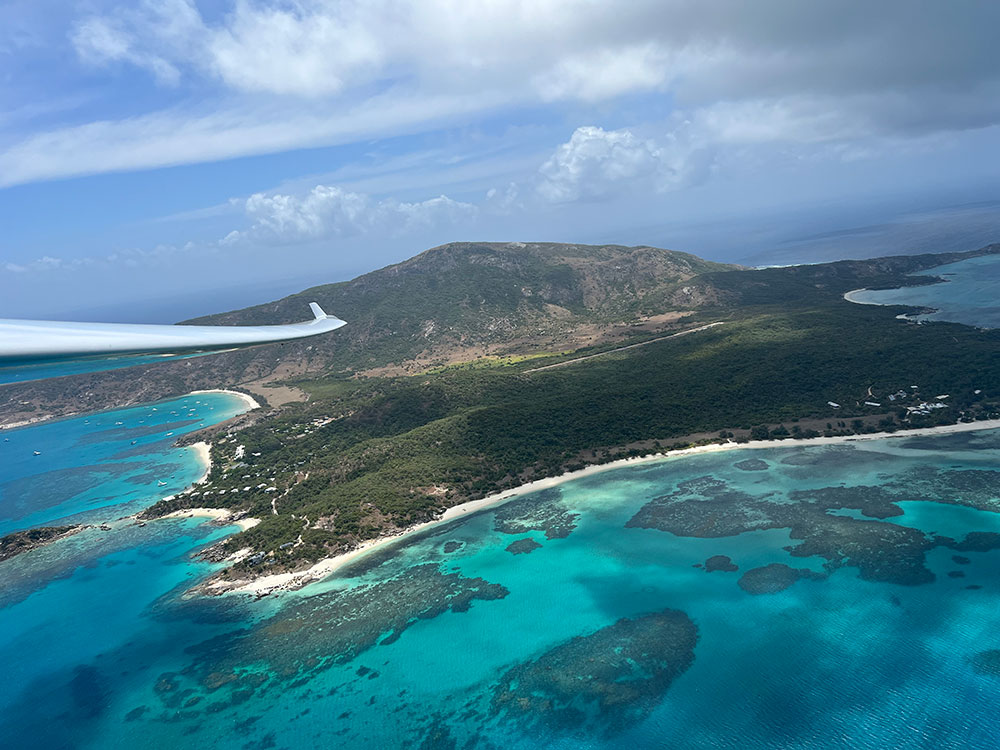
Flying past Lizard Island on the east coast of Queensland on the way back to Lake Keepit.
This story was first published in the Southern Cross Gliding Club journal.































